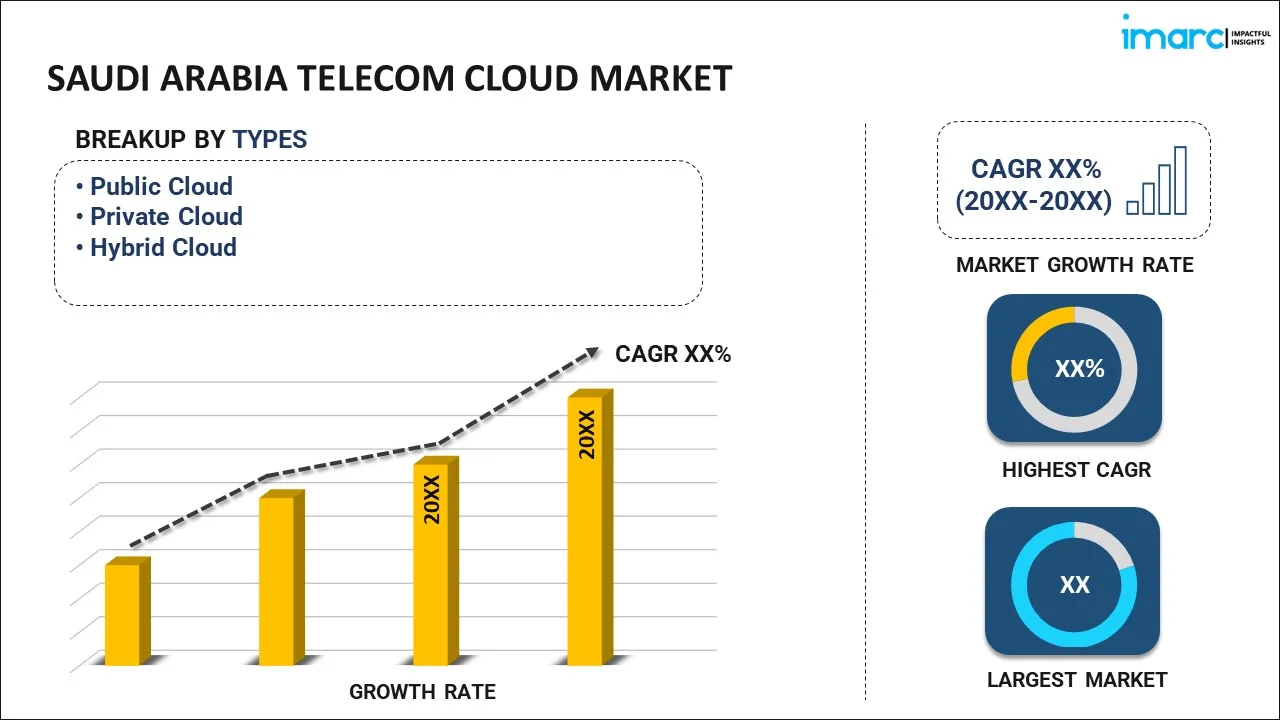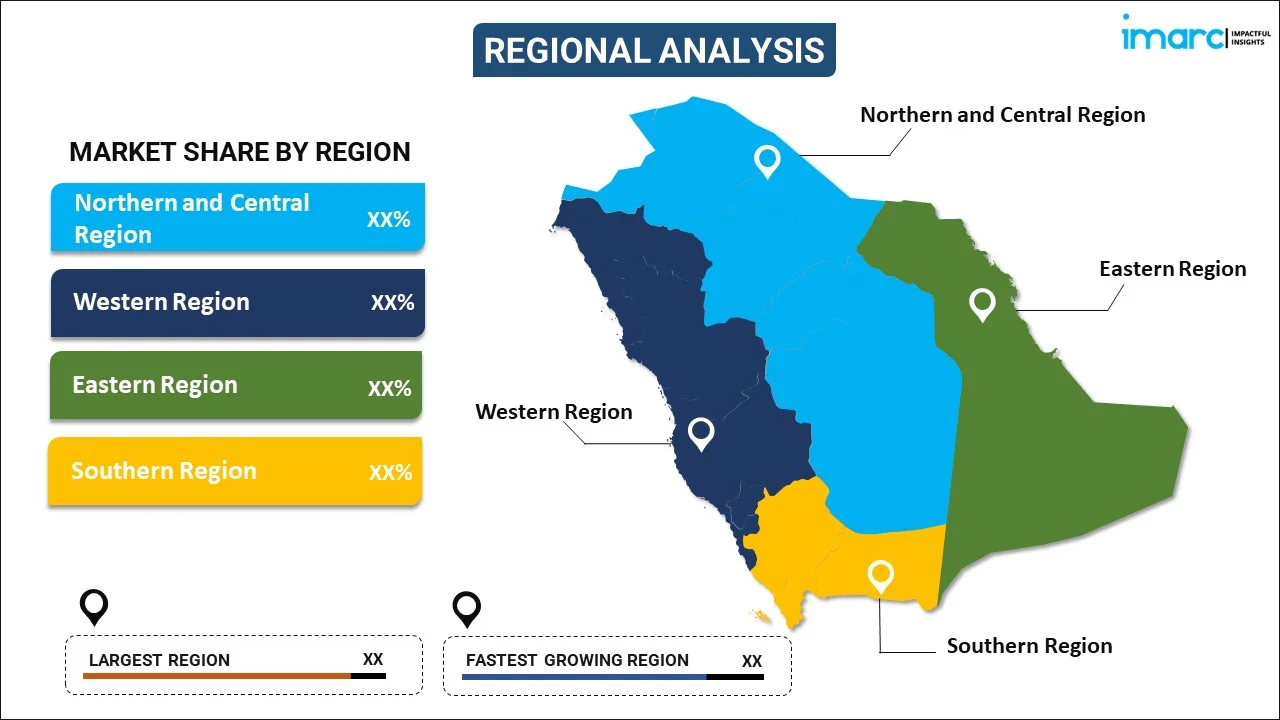
Saudi Arabia Telecom Cloud Market Report by Type (Public Cloud, Private Cloud, Hybrid Cloud), Computing Services (SaaS, IaaS, PaaS), Application (Computing, Data Storage, Achieving, Enterprise Application, and Others), End User (BFSI, Retail, Manufacturing, Transportation and Distribution, Healthcare, Government, Media and Entertainment, and Others), and Region 2025-2033
Market Overview:
Saudi Arabia telecom cloud market size reached USD 462.7 Million in 2024. Looking forward, IMARC Group expects the market to reach USD 2,164.7 Million by 2033, exhibiting a growth rate (CAGR) of 18.7% during 2025-2033. The growing demand for data-intensive services, such as video streaming, Internet of Things, and cloud-based applications, which is pushing telecom operators to adopt cloud solutions to handle the increased data traffic, is driving the market.
|
Report Attribute
|
Key Statistics
|
|---|---|
|
Base Year
|
2024 |
|
Forecast Years
|
2025-2033
|
|
Historical Years
|
2019-2024
|
| Market Size in 2024 | USD 462.7 Million |
| Market Forecast in 2033 | USD 2,164.7 Million |
| Market Growth Rate (2025-2033) | 18.7% |
Telecom cloud refers to the integration of cloud computing technologies with telecommunications networks to enhance the delivery of communication services. It enables the virtualization and centralization of network functions, allowing telecom operators to deploy and manage services more efficiently. Telecom cloud leverages the scalability, flexibility, and cost-effectiveness of cloud infrastructure to support various communication services, such as voice, data, and multimedia. This convergence of telecommunications and cloud computing enables operators to dynamically allocate resources, optimize network performance, and rapidly deploy new services. It facilitates the transition from traditional hardware-based infrastructure to a more agile and software-driven model, fostering innovation and accelerating the deployment of next-generation technologies like 5G. The telecom cloud plays a pivotal role in transforming the telecommunications industry by providing a scalable and adaptable platform for delivering advanced and reliable communication services to a wide range of audiences.
Saudi Arabia Telecom Cloud Market Trends:
The telecom cloud market in Saudi Arabia is experiencing robust growth, propelled by a confluence of factors. Firstly, the increasing demand for scalable and flexible network infrastructure is a primary driver. As businesses expand regionally, the need for agile communication solutions becomes paramount, and the telecom cloud offers a scalable framework to meet these demands. Moreover, the rising adoption of 5G technology acts as a catalyst, necessitating advanced cloud-based architectures to support the enhanced connectivity and data speeds associated with the fifth-generation wireless network. In addition to technological advancements, cost-efficiency remains a pivotal factor fueling the telecom cloud market. By leveraging cloud-based services, telecom operators can optimize their operational expenses, streamline resource allocation, and improve overall efficiency. Furthermore, the growing trend of digital transformation across industries is pushing organizations to embrace cloud-based communication solutions, creating a sustained demand for telecom cloud services. The increasing prevalence of remote work and the surge in data consumption further contribute to the market's momentum. As businesses and consumers alike generate and transmit vast amounts of data, telecom cloud solutions offer a reliable and scalable platform to manage and process this information efficiently. In essence, a combination of technological evolution, cost considerations, and changing work dynamics propels the regional telecom cloud market forward, making it a key player in the contemporary telecommunications landscape.
Saudi Arabia Telecom Cloud Market Segmentation:
IMARC Group provides an analysis of the key trends in each segment of the market, along with forecasts at the country level for 2025-2033. Our report has categorized the market based on type, computing services, application, and end user.
Type Insights:

- Public Cloud
- Private Cloud
- Hybrid Cloud
The report has provided a detailed breakup and analysis of the market based on the type. This includes public cloud, private cloud, and hybrid cloud.
Computing Services Insights:
- SaaS
- IaaS
- PaaS
A detailed breakup and analysis of the market based on the computing services have also been provided in the report. This includes saas, iaas, and paas.
Application Insights:
- Computing
- Data Storage
- Achieving
- Enterprise Application
- Others
The report has provided a detailed breakup and analysis of the market based on the application. This includes computing, data storage, achieving, enterprise application, and others.
End User Insights:
- BFSI
- Retail
- Manufacturing
- Transportation and Distribution
- Healthcare
- Government
- Media and Entertainment
- Others
A detailed breakup and analysis of the market based on the end user have also been provided in the report. This includes BFSI, retail, manufacturing, transportation and distribution, healthcare, government, media and entertainment, and others.
Regional Insights:

- Northern and Central Region
- Western Region
- Eastern Region
- Southern Region
The report has also provided a comprehensive analysis of all the major regional markets, which include Northern and Central Region, Western Region, Eastern Region, and Southern Region.
Competitive Landscape:
The market research report has also provided a comprehensive analysis of the competitive landscape in the market. Competitive analysis such as market structure, key player positioning, top winning strategies, competitive dashboard, and company evaluation quadrant has been covered in the report. Also, detailed profiles of all major companies have been provided.
Saudi Arabia Telecom Cloud Market Report Coverage:
| Report Features | Details |
|---|---|
| Base Year of the Analysis | 2024 |
| Historical Period | 2019-2024 |
| Forecast Period | 2025-2033 |
| Units | Million USD |
| Scope of the Report | Exploration of Historical Trends and Market Outlook, Industry Catalysts and Challenges, Segment-Wise Historical and Future Market Assessment:
|
| Types Covered | Public Cloud, Private Cloud, Hybrid Cloud |
| Computing Services Covered | SaaS, IaaS, PaaS |
| Applications Covered | Computing, Data Storage, Achieving, Enterprise Application, Others |
| End Users Covered | BFSI, Retail, Manufacturing, Transportation and Distribution, Healthcare, Government, Media and Entertainment, Others |
| Regions Covered | Northern and Central Region, Western Region, Eastern Region, Southern Region |
| Customization Scope | 10% Free Customization |
| Post-Sale Analyst Support | 10-12 Weeks |
| Delivery Format | PDF and Excel through Email (We can also provide the editable version of the report in PPT/Word format on special request) |
Key Questions Answered in This Report:
- How has the Saudi Arabia telecom cloud market performed so far and how will it perform in the coming years?
- What has been the impact of COVID-19 on the Saudi Arabia telecom cloud market?
- What is the breakup of the Saudi Arabia telecom cloud market on the basis of type?
- What is the breakup of the Saudi Arabia telecom cloud market on the basis of computing Services?
- What is the breakup of the Saudi Arabia telecom cloud market on the basis of application?
- What is the breakup of the Saudi Arabia telecom cloud market on the basis of end user?
- What are the various stages in the value chain of the Saudi Arabia telecom cloud market?
- What are the key driving factors and challenges in the Saudi Arabia telecom cloud?
- What is the structure of the Saudi Arabia telecom cloud market and who are the key players?
- What is the degree of competition in the Saudi Arabia telecom cloud market?
Key Benefits for Stakeholders:
- IMARC’s industry report offers a comprehensive quantitative analysis of various market segments, historical and current market trends, market forecasts, and dynamics of the Saudi Arabia telecom cloud market from 2019-2033.
- The research report provides the latest information on the market drivers, challenges, and opportunities in the Saudi Arabia telecom cloud market.
- Porter's five forces analysis assist stakeholders in assessing the impact of new entrants, competitive rivalry, supplier power, buyer power, and the threat of substitution. It helps stakeholders to analyze the level of competition within the Saudi Arabia telecom cloud industry and its attractiveness.
- Competitive landscape allows stakeholders to understand their competitive environment and provides an insight into the current positions of key players in the market.
Need more help?
- Speak to our experienced analysts for insights on the current market scenarios.
- Include additional segments and countries to customize the report as per your requirement.
- Gain an unparalleled competitive advantage in your domain by understanding how to utilize the report and positively impacting your operations and revenue.
- For further assistance, please connect with our analysts.
 Inquire Before Buying
Inquire Before Buying
 Speak to an Analyst
Speak to an Analyst
 Request Brochure
Request Brochure
 Request Customization
Request Customization




.webp)




.webp)












